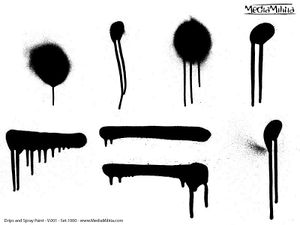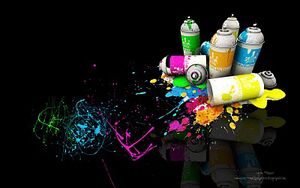Spray Paint
Spray painting is a painting technique where a device sprays a coating (paint, ink, varnish, etc.) through the air onto a surface. The most common types employ compressed gas—usually air—to atomize and direct the paint particles. Spray guns evolved from airbrushes, and the two are usually distinguished by their size and the size of the spray pattern they produce. Airbrushes are hand-held and used instead of a brush for detailed work such as photo retouching, painting nails or fine art. Air gun spraying uses equipment that is generally larger. It is typically used for covering large surfaces with an even coating of liquid. Spray guns can be either automated or hand-held and have interchangeable heads to allow for different spray patterns. Single color aerosol paint cans are portable and easy to store.
History
Francis Davis Millet is generally credited with the invention of spray painting. In 1892, working under extremely tight deadlines to complete construction of the World's Columbian Exposition, Daniel Burnham appointed Millet to replace the fair's official director of color, William Pretyman. Pretyman had resigned following a dispute with Burnham. After experimenting, Millet settled on a mix of oil and white lead that could be applied using a hose and special nozzle, which would take considerably less time than traditional brush painting.
In 1949, Edward Seymour developed spray paint that could be delivered from an aerosol can.
Types
Air gun spraying
This process occurs when paint is applied to an object through the use of an air-pressurized spray gun. The air gun has a nozzle, paint basin, and air compressor. When the trigger is pressed the paint mixes with the compressed air stream and is released in a fine spray.
Due to a wide range of nozzle shapes and sizes, the consistency of the paint can be varied. The shape of the workpiece and the desired paint consistency and pattern are important factors when choosing a nozzle. The three most common nozzles are the full cone, hollow cone, and flat stream. There are two types of air-gun spraying processes. In a manual operation method the air-gun sprayer is held by a skilled operator, about 6 to 10 inches (15–25 cm) from the object, and moved back and forth over the surface, each stroke overlapping the previous to ensure a continuous coat. In an automatic process the gun head is attached to a mounting block and delivers the stream of paint from that position. The object being painted is usually placed on rollers or a turntable to ensure overall equal coverage of all sides.
HVLP (High Volume Low Pressure)
This is similar to a conventional spray gun using a compressor to supply the air, but the spray gun itself requires a lower pressure (LP). A higher volume (HV) of air is used to aerosolise and propel the paint at lower air pressure. The result is a higher proportion of paint reaching the target surface with reduced overspray, materials consumption, and air pollution. A regulator is often required so that the air pressure from a conventional compressor can be lowered for the HVLP spray gun. Alternatively a turbine unit (commonly containing a vacuum cleaner derived motor) can be used to propel the air without the need for an air line running to the compressor.
A rule of thumb puts two thirds of the coating on the substrate and one third in the air. True HVLP guns use 8–20 cfm (13.6–34 m3/hr), and an industrial compressor with a minimum of 5 horsepower (3.7 kW) output is required. HVLP spray systems are used in the automotive, decorative, marine, architectural coating, furniture finishing, scenic painting and cosmetic industries. LVLP (Low Volume Low Pressure)
Like HVLP, these spray guns also operate at a lower pressure (LP), but they use a low volume (LV) of air when compared to conventional and HVLP equipment. This is a further effort at increasing the transfer efficiency (amount of coating that ends up on the target surface) of spray guns, while decreasing the amount of compressed air consumption.
Electrostatic spray painting
Electrostatic painting was first patented in the U.S. by Harold Ransburg in the late 1940s. Harold Ransburg founded Ransburg Electrostatic Equipment and discovered that electrostatic spray painting was an immediate success as manufacturers quickly perceived the substantial materials savings that could be achieved. In electrostatic spray painting or powder coating, the atomized particles are made to be electrically charged, thereby repelling each other and spreading themselves evenly as they exit the spray nozzle. The object being painted is charged oppositely or grounded. The paint is then attracted to the object giving a more even coat than wet spray painting, and also greatly increasing the percentage of paint that sticks to the object. This method also means that paint covers hard to reach areas. The whole may then be baked to properly attach the paint: the powder turns into a type of plastic. Car body panels and bike frames are two examples where electrostatic spray painting is often used. Air assisted airless spray guns.
These use air pressure and fluid pressure 300 to 3,000 pounds per square inch (2,100–21,000 kPa) to achieve atomization of the coating. This equipment provides high transfer and increased application speed and is most often used with flat-line applications in factory finish shops. The fluid pressure is provided by an airless pump, which allows much heavier materials to be sprayed than is possible with an airspray gun. Compressed air is introduced into the spray from an airless tip (nozzle) to improve the fineness of atomisation. Some electric airless sprayers are fitted with a compressor to allow the use of an air assisted airless gun in situations where portability is important.
Airless spray guns
These operate connected to a high pressure pump commonly found using 300 to 7,500 pounds per square inch (2,100–52,000 kPa) pressure to atomize the coating, using different tip sizes to achieve desired atomization and spray pattern size. This type of system is used by contract painters to paint heavy duty industrial, chemical and marine coatings and linings.
Automated linear spray systems
Manufacturers who mass-produce wood products use automated spray systems, allowing them to paint materials at a very high rate with a minimum of personnel. Automated spray systems usually incorporate a paint-saving system which recovers paint not applied to the products. Commonly, linear spray systems are for products which are lying flat on a conveyor belt and then fed into a linear spray system, where automated spray guns are stationed above. When the material is directly below the guns, the guns begin to paint the material. Materials consist of lineal parts usually less than 12 inches (30 cm) wide, such as window frames, wood moulding, baseboard, casing, trim stock and any other material that is simple in design. These machines are commonly used to apply stain, sealer, and lacquer. They can apply water- or solvent-based coatings. In recent years ultraviolet-cured coatings have become commonplace in profile finishing, and there are machines particularly suited to this type of coating.
Automated flatline spray systems
Mass produced material is loaded on a conveyor belt where it is fed into one of these flatline machines. Flatline machines are designed to specifically paint material that is less than 4 inches (10 cm) thick and complex in shape, for example a kitchen cabinet door or drawer front. Spray guns are aligned above the material and the guns are in motion in order to hit all the grooves of the material. The guns can be moved in a cycle, circle, or can be moved back and forth in order to apply paint evenly across the material. Flatline systems are typically large and can paint doors, kitchen cabinets, and other plastic or wooden products.
Spray booth
A spray booth is a pressure controlled closed environment, used to paint vehicles in a body shop. To ensure the ideal working conditions (temperature, air flow and humidity), these environments are equipped with one or more groups of ventilation, consisting of one or more motors and one or more burners to heat the air blown. In order to assist in the removal of the oversprayed paint from the air and to provide efficient operation of the down-draft, water-washed paint spray booths utilize paint detackifying chemical agents.
Video

